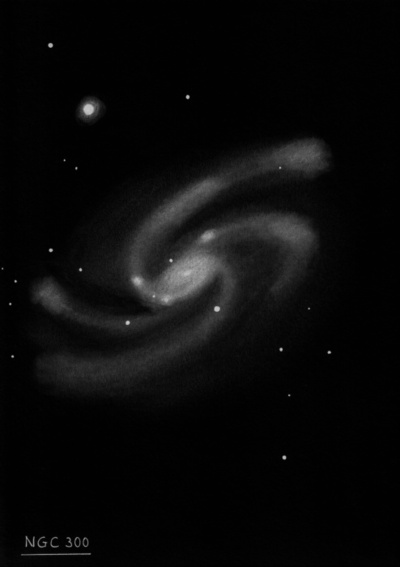
15x50 IS binoculars: (11/18/06): visible in binoculars as a relatively large, very low surface brightness hazy region, roughly 15' in size. A star is superimposed on the SW side.
James Dunlop discovered NGC 300 = D 530 = h2359 on 5 Aug 1826 with his 9" reflector and described "a pretty large faint nebula, irregular round figure, 6' or 7' diameter, easily resolvable into exceedingly minute stars, with four or five stars of more considerable magnitude; slight compression of stars to the centre." There are several superimposed Milky Way stars, although the resolution towards the center was spurious, of course. His position was 8' too far east.
John Herschel observed the galaxy on 3 occasions. On the first sweep (1 Sep 1834) he described it as "B; vL; vgpmbM; vmE; irregular figure; 8' to 10' long, 3' or 4' broad; has subordinate nuclei." His sketch (plate V, figure 10) includes the nucleus and two or three additional regions of nebulosity. Three nights later, he noted it as "faint, very large, very gradually brighter towards the middle; 4' long; 2' broad; has another nebula attached." The secondary nebula is the large HII complex [DCL88] 137 on the east side. On 30 Nov 1837 he wrote: "A large oval nebula, containing three stars." He had tentatively identified it with Dunlop 530, but noted: "Mr. Dunlop's neb 530 is described by him as easily resolvable into very minute stars. Its identity with [NGC 300] is therefore very doubtful."
Joseph Turner sketched NGC 300 with the 48" Great Melbourne Telescope on 20 Dec 1875 (plate I, figure 3). The giant HII complex on the east side is clearly shown on the sketch as a distinct oval patch. Pietro Baracchi showed it on his sketch from 7 Oct 1884 as a relatively large patch making a nearly equilateral triangle with two superimposed stars to the south. The galaxy was photographed by Harold Knox-Shaw at the Helwan Observatory between 1909-11 and described as a "spiral with many conensations".
300/350mm - 13.1" (9/22/84): fairly large oval 3:2 WNW-ESE, very diffuse appearance, bright stellar nucleus. There is a hint of structure although the galaxy has a low surface brightness and was viewed at a low elevation (13° at most) from my latitude of +38.5°. This nearby galaxy is located at a distance of 6 million light years in the Sculptor group, and may be physically paired with NGC 55.
600/800mm - 25" (10/21/17 - OzSky): at 187x; bright, extremely large, irregular, elongated roughly 5:3 WNW-ESE, at least 15'x9'. Contains a large, brighter core region with a mag 11.5 star at the ENE edge of the core. A mag 9.6 star is in the halo (along a faint spiral arm), 2.6' SW of center and a mag 10.6 star is superimposed in the outer halo, 5.3' SE of center. Spiral structure was surprisingly subtle. A low contrast, broad inner arm extends west from the north side of the core, curls south on the west side and spreads out. A more obvious inner arm emerges from the south side of the core and sweeps east and north, though the root of the arm is not defined. The arm passes through a relatively bright and large HII patch/OB association, ~25" diameter, situated 3.9' E of center and loses contrast further north. This giant HII complex is catalogued in NED as NGC 300:[DCL88] 137 from a 1988 study by Deharveng et al, "H II regions in NGC 300". A mag 11.5 star is 2.3' further NE in the outer halo of the galaxy. I didn't have time to examine the galaxy at higher power to search for additional H II knots.
Notes by Steve Gottlieb